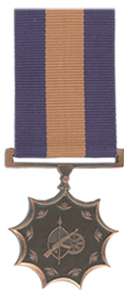Merit Medal in Bronze
The Merit Medal in Bronze, post-nominal letters MMB, was instituted by the President of the Republic of South Africa in April 1996. It was awarded to veteran cadres of Umkhonto we Sizwe, the military wing of the African National Congress, who had distinguished themselves during the "struggle" by service of a high order.[1][2]
| Merit Medal in Bronze | |
|---|---|
 | |
| Awarded by the President | |
| Country | |
| Type | Military decoration for merit |
| Eligibility | Umkhonto we Sizwe cadres |
| Awarded for | Service of a high order |
| Campaign(s) | The "struggle" |
| Status | Discontinued in 2003 |
| Post-nominals | MMB |
| Statistics | |
| Established | 1996 |
| MK 1996 & SANDF post-2002 orders of wear | |
| Next (higher) | MK precedence:
SANDF precedence:
|
| Next (lower) | MK succession:
SANDF succession:
|
Ribbon bar | |
Umkhonto we Sizwe
Umkhonto we Sizwe, abbreviated as MK, "Spear of the Nation" in Zulu, was the para-military wing of the African National Congress (ANC). It was established on 16 December 1961 to wage an armed "struggle" against the Nationalist government inside South Africa. On 27 April 1994, Umkhonto we Sizwe was amalgamated with six other military forces into the South African National Defence Force (SANDF).[1][3][4]
Institution
The Merit Medal in Bronze, post-nominal letters MMB, was instituted by the President of South Africa in April 1996. It is the junior award of a set of three decorations for merit, along with the Decoration for Merit in Gold and the Merit Medal in Silver.[1][2][5]
Umkhonto we Sizwe's military decorations and medals were modelled on those of the South African Defence Force and these three decorations are the approximate equivalents of, respectively, the Southern Cross Decoration and Pro Merito Decoration, the Southern Cross Medal (1975) and Pro Merito Medal (1975), and the Military Merit Medal.[5]
Award criteria
The decoration could be awarded to veteran cadres of Umkhonto we Sizwe who had distinguished themselves during the "struggle" by service of a high order.[1][5]
Order of wear
The position of the Merit Medal in Bronze in the official military and national orders of precedence was revised upon the institution of a new set of honours on 27 April 2003.[5][6]
- Umkhonto we Sizwe
![]()
![]()
![]()
- Official MK order of precedence:
- Preceded by the Merit Medal in Silver (MMS).
- Succeeded by the Operational Medal for Southern Africa.[5]
- South African National Defence Force until 26 April 2003
![]()
![]()
![]()
- Official SANDF order of precedence:
- Preceded by the Bronze Medal for Merit (BMM) of the Azanian People's Liberation Army.
- Succeeded by the Chief C.D.F. Commendation Medal of the Republic of Ciskei.[5]
- Official national order of precedence:
- Preceded by the Bronze Medal for Merit (BMM) of the Azanian People's Liberation Army.
- Succeeded by the Chief C.D.F. Commendation Medal of the Republic of Ciskei.[5]
- South African National Defence Force from 27 April 2003
![]()
![]()
![]()
- Official SANDF order of precedence:
- Preceded by the Bronze Medal for Merit (BMM) of the Azanian People's Liberation Army.
- Succeeded by the iPhrothiya yeBhronzi (PB) of the Republic of South Africa.[5]
- Official national order of precedence:
- Preceded by the Bronze Medal for Merit (BMM) of the Azanian People's Liberation Army.
- Succeeded by the iPhrothiya yeBhronzi (PB) of the Republic of South Africa.[5]
Description
- Obverse
The Merit Medal in Bronze was struck in bronze and has an engrailed edge which has nine points, to fit in a circle 38 millimetres in diameter. It depicts the Umkhonto we Sizwe emblem and a protea flower in each of the nine points.[1][7]
- Ribbon
The ribbon is 32 millimetres wide and dark blue, with a 12 millimetres wide dark yellow band in the centre.[1][7]
Discontinuation
Conferment of the Merit Medal in Bronze was discontinued upon the institution of a new set of honours on 27 April 2003.[6]
References
- South African Medal Website - Liberation armies (Accessed 30 April 2015)
- South African Medal Website - Post-nominal Letters (Accessed 28 April 2015)
- "Manifesto of Umkhonto we Sizwe". African National Congress. 16 December 1961. Archived from the original on 17 December 2006. Retrieved 30 December 2006.
- Warrant of the President of the Republic of South Africa for the Institution of the "UNITAS MEDAL-UNITAS-MEDALJE", Gazette no. 16087 dated 25 November 1994.
- Republic of South Africa Government Gazette Vol. 477, no. 27376, Pretoria, 11 March 2005, OCLC 72827981
- Presidential Warrant by the President of the Republic of South Africa for the Institution of Honours for Bravery in the South African National Defence Force, Gazette no. 25213 dated 25 July 2003.
- Uniform: SA Army: Former Forces Medals - Umkhonto Wesizwe (MK)